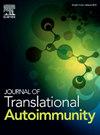The interplay between epidermal barrier distribution, microbiota composition, and immune infiltrate defines and stratifies psoriasis patients and is associated with disease severity
IF 3.6
Q2 IMMUNOLOGY
引用次数: 0
Abstract
Psoriasis is a chronic inflammatory autoimmune skin disease characterized by keratinocyte hyperproliferation, primarily driven by the IL-23/IL-17 axis. In addition to immune response, various skin components, including the epidermal barrier and the skin microbiota, have been individually implicated in the disease pathogenesis. Here, we aimed to investigate the interplay between epidermal tight junctions, Staphylococcus aureus enterotoxin B (SEB), and CD4 T cell-mediated immune responses. By immunofluorescence analyses of skin biopsies, we observed that claudin-1 distribution was significantly altered in psoriatic patients, which correlated with the localization of Staphylococcus aureus and SEB across skin layers and with disease severity. Furthermore, functional CD4 TCRvβ17 cells were associated with SEB presence in patients skin and positively correlated with psoriasis severity. Notably, in patients with SEB detected in the dermis, CD4 TCRvβ17 IL-17 cells were linked to barrier abnormalities.
Unsupervised analysis stratified psoriasis patients into three groups based on SEB presence and location, supporting the previous findings. The patient group with SEB in the dermis exhibited improved responses to biological therapy, including reductions in PASI score, claudin-1 fragmentation, S. aureus and SEB presence, and CD4 TCRvβ17 cell percentages. Our findings emphasize the complex interplay between epidermal barrier distribution, SEB localization, and functional CD4 TCRvβ17 cells in psoriatic skin, highlighting their potential in patient stratification in association with the severity of the disease.
表皮屏障分布、微生物群组成和免疫浸润之间的相互作用决定了银屑病患者的定义和分层,并与疾病的严重程度有关
银屑病是一种慢性炎症性自身免疫性皮肤病,以角质形成细胞过度增殖为特征,主要由 IL-23/IL-17 轴驱动。除免疫反应外,包括表皮屏障和皮肤微生物群在内的各种皮肤成分也与该病的发病机制有关。在这里,我们旨在研究表皮紧密连接、金黄色葡萄球菌肠毒素 B(SEB)和 CD4 T 细胞介导的免疫反应之间的相互作用。通过对皮肤活检组织进行免疫荧光分析,我们观察到银屑病患者的 claudin-1 分布发生了显著变化,这与金黄色葡萄球菌和 SEB 在皮肤各层的定位以及疾病的严重程度相关。此外,功能性 CD4 TCRvβ17 细胞与患者皮肤中 SEB 的存在有关,并与银屑病的严重程度呈正相关。值得注意的是,在真皮层检测到SEB的患者中,CD4 TCRvβ17 IL-17细胞与屏障异常有关。无监督分析根据SEB的存在和位置将银屑病患者分为三组,支持了之前的研究结果。真皮中存在SEB的患者组对生物疗法的反应有所改善,包括PASI评分、Claudin-1片段、金黄色葡萄球菌和SEB的存在以及CD4 TCRvβ17细胞百分比的降低。我们的研究结果强调了银屑病皮肤中表皮屏障分布、SEB定位和功能性CD4 TCRvβ17细胞之间复杂的相互作用,突出了它们与疾病严重程度相关的患者分层潜力。
本文章由计算机程序翻译,如有差异,请以英文原文为准。
求助全文
约1分钟内获得全文
求助全文
来源期刊

Journal of Translational Autoimmunity
Medicine-Immunology and Allergy
CiteScore
7.80
自引率
2.60%
发文量
33
审稿时长
55 days
 求助内容:
求助内容: 应助结果提醒方式:
应助结果提醒方式:


